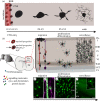Fine-tuning the central nervous system: microglial modelling of cells and synapses
- PMID: 25225087
- PMCID: PMC4173279
- DOI: 10.1098/rstb.2013.0593
Fine-tuning the central nervous system: microglial modelling of cells and synapses
Abstract
Microglia constitute as much as 10-15% of all cells in the mammalian central nervous system (CNS) and are the only glial cells that do not arise from the neuroectoderm. As the principal CNS immune cells, microglial cells represent the first line of defence in response to exogenous threats. Past studies have largely been dedicated to defining the complex immune functions of microglial cells. However, our understanding of the roles of microglia has expanded radically over the past years. It is now clear that microglia are critically involved in shaping neural circuits in both the developing and adult CNS, and in modulating synaptic transmission in the adult brain. Intriguingly, microglial cells appear to use the same sets of tools, including cytokine and chemokine release as well as phagocytosis, whether modulating neural function or mediating the brain's innate immune responses. This review will discuss recent developments that have broadened our views of neuro-glial signalling to include the contribution of microglial cells.
Keywords: cerebral cortex; microglia; neuroblasts; neurogenesis; neurons; synapse.
© 2014 The Author(s) Published by the Royal Society. All rights reserved.
Figures


Similar articles
-
Cytokine Signalling at the Microglial Penta-Partite Synapse.Int J Mol Sci. 2021 Dec 7;22(24):13186. doi: 10.3390/ijms222413186. Int J Mol Sci. 2021. PMID: 34947983 Free PMC article. Review.
-
Functions of microglia in the central nervous system--beyond the immune response.Neuron Glia Biol. 2011 Feb;7(1):47-53. doi: 10.1017/S1740925X12000063. Epub 2012 May 22. Neuron Glia Biol. 2011. PMID: 22613055 Review.
-
Snapshot of microglial physiological functions.Neurochem Int. 2021 Mar;144:104960. doi: 10.1016/j.neuint.2021.104960. Epub 2021 Jan 15. Neurochem Int. 2021. PMID: 33460721 Review.
-
Dual functions of microglia in the formation and refinement of neural circuits during development.Int J Dev Neurosci. 2019 Oct;77:18-25. doi: 10.1016/j.ijdevneu.2018.09.009. Epub 2018 Oct 4. Int J Dev Neurosci. 2019. PMID: 30292872 Review.
-
The role of microglia at synapses in the healthy CNS: novel insights from recent imaging studies.Neuron Glia Biol. 2011 Feb;7(1):67-76. doi: 10.1017/S1740925X12000038. Epub 2012 Mar 15. Neuron Glia Biol. 2011. PMID: 22418067 Review.
Cited by
-
Key Aging-Associated Alterations in Primary Microglia Response to Beta-Amyloid Stimulation.Front Aging Neurosci. 2017 Aug 31;9:277. doi: 10.3389/fnagi.2017.00277. eCollection 2017. Front Aging Neurosci. 2017. PMID: 28912710 Free PMC article.
-
Understanding the MIND phenotype: macrophage/microglia inflammation in neurocognitive disorders related to human immunodeficiency virus infection.Clin Transl Med. 2015 Feb 26;4:7. doi: 10.1186/s40169-015-0049-2. eCollection 2015. Clin Transl Med. 2015. PMID: 25852823 Free PMC article.
-
Comparison of Microglial Morphology and Function in Primary Cerebellar Cell Cultures on Collagen and Collagen-Mimetic Hydrogels.Biomedicines. 2022 Apr 29;10(5):1023. doi: 10.3390/biomedicines10051023. Biomedicines. 2022. PMID: 35625762 Free PMC article.
-
Social defeat induces depressive-like states and microglial activation without involvement of peripheral macrophages.J Neuroinflammation. 2016 Aug 31;13(1):224. doi: 10.1186/s12974-016-0672-x. J Neuroinflammation. 2016. PMID: 27581371 Free PMC article.
-
Adolescent alcohol drinking interaction with the gut microbiome: implications for adult alcohol use disorder.Adv Drug Alcohol Res. 2024;4:11881. doi: 10.3389/adar.2024.11881. Epub 2024 Jan 15. Adv Drug Alcohol Res. 2024. PMID: 38322648 Free PMC article.
References
Publication types
MeSH terms
Substances
Grants and funding
LinkOut - more resources
Full Text Sources
Other Literature Sources
Research Materials
Miscellaneous

